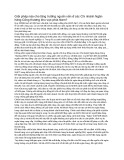
JOURNAL OF
Veterinary
Science
J. Vet. Sci.
(2006),
7
(1), 1–11
BSE situation and establishment of Food Safety Commission in Japan
Takashi Onodera*, Chi-Kyeong Kim
Department of Mo lec ular Im muno logy, Graduate Sch ool o f Agric ultu ral and Life Sci ence s, U niver sity of Toky o, Yay oi 1- 1-1 ,
Tokyo 113-8657, Japa n
Eight major policies were implemented by Japanese
Government since Oct. 2001, to deal with bovine spongiform
encephalopathy (BSE). These are; 1) Surveillance in farm
by veterinarian, 2) Prion test at healthy 1.3mi cows/yr, by
veterinarian, 3) Elimination of specified risk material
(SRM), 4) Ban of MBM for production, sale use, 5) Prion
test for fallen stocks, 6) Transparent information and
traceability, 7) New Measures such as Food Safety Basic
Law, and 8) Establish of Food Safety Commission in the
Cabinet Office. At this moment, the extent of SRM risk
has only bee n indic ate d by s eve ral reports employi ng tes ts
with a limited sensitivity. There is still a possibility that
the items in the SRM list will increase in the future, and
this indiscriminately applies to Japanese cattle as well.
Although current practices of SRM elimination partially
guarantee total food safety, additional latent problems
and imminent issues remain as potential headaches to be
addressed. If the index of SRM elimination cannot
guarantee reliable food safety, we have but to resort to
total elimination of tissues from high risk-bearing and
BSE-infected animals. However, current BSE tests have
their limitations and can not yet completely detect high-
risk and/or infected animals. Under such circumstances,
tissues/wastes and remains of diseased, affected fallen
stocks and cohort animals have to be eliminated to
pre vent BSE invadi ng the human food cha in sys tems. The
failure to detect any cohort should never be allowed to
occur, and with regular and persistent updating of
available stringent records, we are at least adopting the
correct and useful approach as a reawakening strategy to
securing food safety . In this perspective, traceability based
on a National Ide ntific ati on Sys tem is r e quired.
Key words:
bovine spongiform encephalopathy, BSE, Food
Safety Comission, specified risk material, surveillance test,
traceability
Introduction
In April 1985 the first cases in the United Kingdom of a
new disease of cattle were seen; bovine spongiform
encephalopathy (BSE) which has comm only become known
as “mad cow disease.” This disease was characterized by
gray matter vacuolation and fibrils similar to those observed
in sheep scr apie [10,20]. Epi demiologica l studies esta blished
the most probable cause of the outbreak of the new disease
as changes in the rendering process for the offal used in
animal feed. This allowed some agent-either scrapie agent
from infected sheep carcasses or a previously uncharacterized
BSE agent-to contaminate high protein cattle feed [22,24].
Between 1981 and 1982 most of the rendering plants had
changed their pr oce ss s uch that th er e w as no lon ger a s olve nt
based fat-extraction step followed by steam distillation of
the solvent. Solvents have been shown to inactivate the
scrapie agent [8]. Without the steam distillation step, the
offal failed to reach the high steam temperature known to
destroy the scrapie agent (138
o
C for 1 hour 3 bars) [3,8,19].
The change in offal processing preceded the subsequent
outbreak of BSE in 1986- 7. It is possibl e that the age nt was
always present in this type of feed, but that the reducti on in
fat content with hydrocarbons and the subsequent steam
treatment of the product kept the number of infectious
particles down so that a clinical disease was not seen (the
disease symptoms being dose related). In Scotland, where
the hydrocarbon extraction continued to be used during high
protein feed production, the number cases of BSE was
significantly fewer per head of cattle in England [23].
The magnitude of the BSE epidemic was probably
amplified by infected cattle being included in the r endering
process. It does appear, however, that BSE is not readily
transmitted either horizontally or vertically [21], and as a
result of feed ban in July 1988 the si ze of the epidemic has
been self-limiting to a large extent [24]. Indeed, the incidence
of disease in cattle born after the feed ban took effect has
dropped dramatically through years [23,24]. However, it is
not clear whether or not maternal t rans mission of BS E does
occur [9].
The start of the BSE epidemic was followed by reports of
*Corresponding author
Tel: +81-3-5841-5196, Fax: +81-3-5841-8020
E-mail: aonoder@mail.ecc.u -tok y o.a c.jp
Review








































